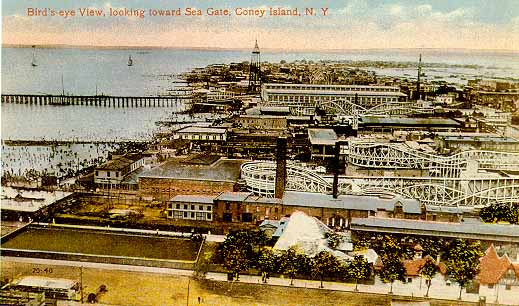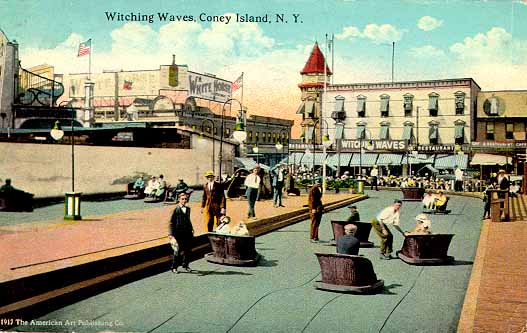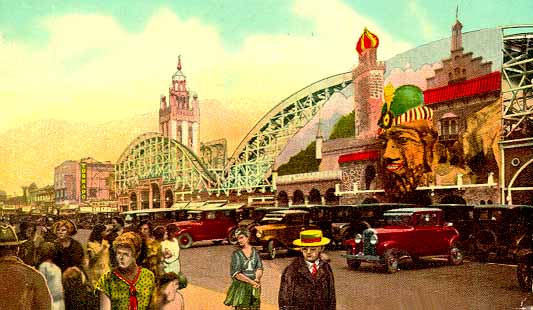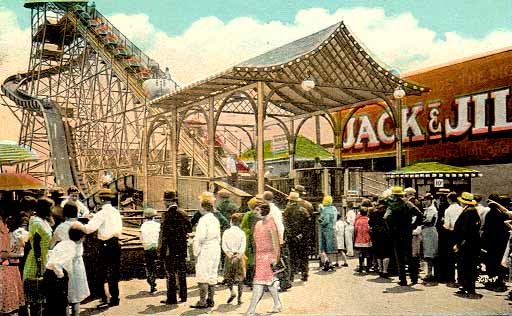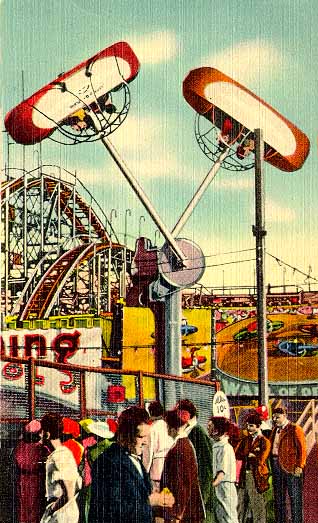Coney Island - Independent Rides
Throughout the decades Coney Island has offered the public innumerable rides and attractions to entertain them. While some of the first were just steam operated carousels and the forerunners of the roller coaster, mere primitive switchback railroads, soon clever inventors rented empty plots of sand along popular streets to install their latest creations. These rides, carried passengers high into the air, spun them around in moving tubs, carried them into dark scenic tunnels, scared them on roller coaster's steep drops, made them laugh in walk-thru fun houses, and bumped and jostled them in steerable Dodgem' cars. It was cheap fun and simple entertainment for people of all ages. The rides were everywhere and most charged only a nickel or a dime.
People, who have read articles about the establishment at the turn of the century of Coney Island's three great amusement parks, Steeplechase, Luna Park and Dreamland, assume that nearly all of the area's rides and attractions were located within. They are mistaken. The acreage that the three parks occupied in what was considered the amusement area between West 5th to West 18th Streets, and from the Beach to perhaps a block north of Surf Avenue, was at the most about 20-25% of the land; much less after Dreamland burned in 1911. Granted many of the lots were occupied by bathhouses, small hotels, beer halls, restaurants and other assorted businesses, but there was plenty of room for more than a half dozen roller coasters and the numerous other rides that were clustered along Surf Avenue, the Bowery and side streets leading to the beach. These smaller rides are hard to chronicle because except for the carousels and Skooter rides, they didn't need a permanent structure. Most were transitory and often owned by different people from season to season. Operators erected them on a rented lot in the spring and dismantled them at the end of the season. Sometimes they remained in the same location for years, but when they lost their popularity they were replaced by a newer more exciting and novel rides.
Perhaps the biggest reason for their success outside of the three enclosed established parks was the sheer number of potential customers that came to the seashore on a busy summer weekend. Two hundred thousand people came to Coney on weekends in 1905; 600,000 by 1915, and over a million after the subway arrived in 1920. Most renting a bathing suit at a bathhouse went to the beach part of the day, then afterwards tried their favorite roller coaster or other ride. Others frequented the amusement parks which each attracted a different clientele.
Luna Park had the most to offer and was more than twice as large as its competition. While it only cost a dime to enter the park and enjoy the free shows, rides were extra. Its managers always tried to obtain the best and most innovative rides with lots of variety and thrills. Dreamland too, charged for individual rides, but most of its attractions were shows or scenic boat rides within buildings. Only its Chutes, Aerial Circle Swing, L.A. Thompson Scenic Railroad, and perhaps Coasting Through Switzerland could be considered thrill rides. Steeplechase was different because it offered a one-price combination ticket for all its attractions. But except for its Ferris Wheel, Steeplechase Horses, one roller coaster, a Racing Derby and later a Bobsled coaster and a Parachute ride, most of its attractions were of the fun house variety and housed in a huge weather proof glass and steel Fun Pavilion.
Carousels
During the period from 1875 to 1900 when life was more genteel than after the turn of the century, carousels were the dominant form of amusement ride. William Vandeveer, who owned several flourishing bathhouses, bought Charles Looff's first carousel in 1875 for his Balmer's Bathing Pavilion located on the beach at the foot of Ocean Parkway. Five years later when Charles Feltman's restaurant business began to flourish, he built a cupolaed octagonal building adjacent to his Pavilion and installed Looff's second menagerie machine at Coney Island. Both of the Looff machines had stationary horses. Then sometime in the 1890's F.E. Bostock imported a Fredrick Savage English carousel. It featured jumping horses and it rotated clockwise, English style.Many of the carousels installed after the turn of the century were supplied by the Mangels and Illions partnership. They worked from a nearby factory where Illions carved the animals and Mangels built the mechanical framework and power train. Their first endeavor, sold to Charles Feltman in 1903, was lavish. The carved horses had stately, powerful poses, and rich, bejeweled trappings gleaming with gold leaf and intense colors. The collaborated again for a machine at Kister's Restaurant on Surf Avenue and another in 1908 for the lobby of the Hotel Eleanor at Stubbman's Beer Garden. A year later, to celebrate his independence from Mangels, Illions refurbished the later carousel's outer row of horses with ones featuring explosive flying manes and powerful straining bodies.
While there were other independent carousels at Coney Island, perhaps the most beautiful and spectacular was the El Dorado, a German manufactured machine installed in the old Johnstown Flood Building at Surf Avenue and West 5th near Dreamland's entrance. It was build by Hugo Hasse of Leipzig Germany and imported by John Jurgens in 1910 at a cost of $150,000. He had to pay more than $30,000 in customs fees. It was installed in a Pavilion with 6000 lamps and a gigantic band organ. The menagerie machine contained three platforms, arranged in ascending tiers, each revolving at different speeds. Its crown-like canopy rose to a height of 42 feet. It featured horses, pigs and other barnyard animals. It barely survived the 1911 Dreamland fire where the heat was so intense that the animal's paint blistered. George Tilyou salvaged it and placed it within his glass enclosed Pavilion of Fun the following year.
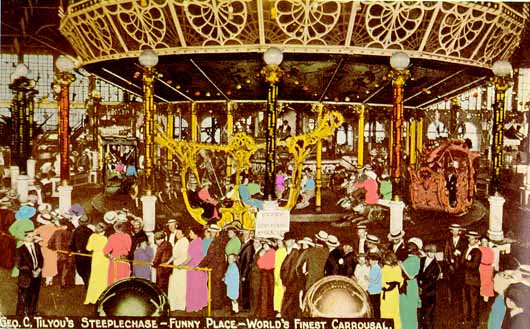
| The El Dorado Carousel was a three-tiered machine. Each platform rotated at different speeds. |
Carousels soon became prolific around Coney Island. George Carmel built a few but Illions built the most, more than a dozen of them, in the 1920's alone. One was located in the Bobs Amusement Department Store on the Bowery at Stillwell. Others were at the Prospect Hotel and on Surf Avenue at W 5th and on Surf Avenue across from Steeplechase. After the Depression began and operators could afford new machines, Illions went bankrupt and closed his factory. Still during the Depression, when rides were a nickel, thirteen were operating at Coney Island. Today only one carousel remains at Coney Island, the B & B merry-go-round. The George Carmel / Murphy & Nunnally machine has been operating on Surf Avenue and W. 10th Street since it was moved there in 1932.
Roller Coasters - 1884 - 1907
The world's first roller coaster, an invention of La Marcus Thompson, debuted at Coney Island on June 13, 1884. Passengers rode a train on undulating tracks over a wooden structure 600 feet long. The train started at a height of 50 feet on one end and ran downhill by gravity until its momentum died. Passengers then left the train and attendants pushed the car over a switch to a higher level. The passengers returned to their sideways facing seats and rode back to the original starting point. Admission on the tame Thompson Switchback Railway was five cents and Thompson grossed an average of $600 / day.Improvements to the roller coaster came rapidly. The following year Alcoke tied the track together at the ends to enable passengers to return to their starting point without the need to disembark while the car was placed on the return track. Alcoke's Serpentine Railroad was slow and took several minutes to complete its circuit.
Another important advance was made at Coney Island in 1885 by Philip Hinkle. He was the first to use a hoist to pull the cars to the top of a precipitous hill. The higher hill meant faster speeds. It was the first to offer forward facing passengers thrills with mild undulations instead of a tour of the countryside.
La Marcus Thompson returned to Coney Island in 1887 after perfecting his Scenic Railroad at Atlantic City, New Jersey. He added tunnels, caves and a grotto which featured illuminated scenes. Steam powered his lift hill. The ride was especially popular with young couples could sneak a quick embrace and sometimes a kiss in the darkened tunnels.
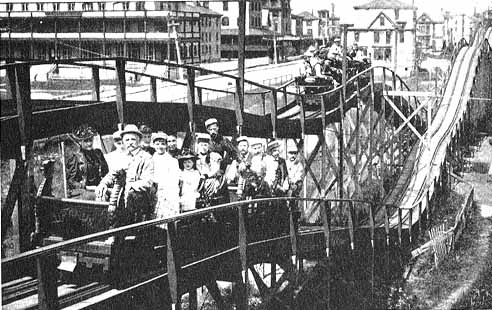
| The LA Thompson Switchback Railway |
Thompson built other scenic railways, one for George Tilyou at Steeplechase Park, and another in 1901 on Surf Avenue near what would become Luna Park's entrance. His Oriental Scenic Railway featured exotic Asian scenery in its tunnels. Although the ride was considered old fashioned, it achieved renewed popularity after 1924 due to its proximity to Luna's more thrilling Mile Sky Chaser which always had long lines.
Looping roller coasters, considered a daredevil ride to the throngs of spectators, debuted at Coney Island in 1895. Lina Beecher's wooden Flip Flap at Sea Lion Park was the first, but the most dangerous. Two passenger cars, descending from a high lift hill, flipped passengers upside down through a small 25 foot diameter circular loop. Its flaw was that its high G-forces sometimes whiplashed, even snapped passenger's necks. Besides it never made much money since park visitors were too timid to ride the contraption. By 1901 when the rival Loop the Loop steel coaster opened on Surf Avenue at West 10th Street, inventor Edward Prescott solved the problem. His use of an elliptical loop eliminated the strains on passengers's necks. However, despite charging admission to watch, it too wasn't successful in generating much revenue because it could only carry four passengers every five minutes.
During the next half dozen years small roller coasters began to spring up on numerous vacant lots along Surf Avenue and The Bowery. Rocky Road to Dublin on Surf Avenue between W. 5th & 8th Streets and Rough Riders on the Bowery at Jones Walk were both 3rd Rail electric powered coasters. A motorman could apply power both uphill and downhill but had to be careful when rounding turns. One reckless operator in 1910 drove the Rough Rider's coaster train too fast on a turn one night and pitched 16 people in two cars from the top of a 60 foot peak. Incredibly only four of them died.
Thompson in 1906 built a scenic railroad on Surf Avenue east of Dreamland called Pikes Peak Railroad. It burned in the Dreamland fire. Another scenic railroad, but entirely indoors, was the Deep Rift Coal Mine Scenic Railroad located next to Luna's entrance on Surf Avenue. Passengers rode in coal mine cars and slowly descended from the lift hill in this gravity ride. The cars passed illuminated life size figures of miners, work animals and machinery that showed the operation of the mine. It debuted in 1906 but was removed the following year when Luna's Surf Avenue entrance was enlarged.
Probably the Cannon Coaster built in 1902 at Henderson's Walk and the Boardwalk was the most steeped in legend. Its designers originally attempted to have the cars leap over a gap in the tracks. At its apex it entered the breech of a large wooden cannon and as it passed through its bore, it accelerated downward. As the train shot out of the cannon's mouth it was supposed to leap a gap in the tracks. They tested the idea with sandbags instead of people, but it didn't work because variations in the passenger's weight or uneven loads sometimes caused crashes. They filled in the gap in this boring ride, but it still drew crowds because stories still circulated of innumerable casualties during its gap-in-the-track test runs.
Towers & Ferris Wheels
Attractions that offered visitors panoramic views of Coney Island were popular at or before the turn of the century. Andrew Culver in 1877 bought the 300 foot tall Iron Tower from the Philadelphia Centennial Exposition and erected in at Coney Island inland from his Iron Pier. It had two steam elevators to whisk tourists to the top where they could use a telescope to see 40 miles out to sea.In 1893 when George Tilyou gazed at the newly invented 250 foot diameter Ferris Wheel at the Chicago World's Columbian Exposition, he knew he had to purchase it. He watched visitors jaws drop and eyes pop as they stared at the enormous wheel with its 36 cars, each accommodating 60 passengers. The huge wheel, and invention of a mechanical engineering graduate from Rensselaer Polytechnic Institute, offered people high panoramic views of the fair as it slowly rotated. Unfortunately this money maker had already been sold to the promoter of the St Louis World's Fair to be held in 1904.
George borrowed money and purchased a smaller half sized 125 foot diameter wheel from the Pennsylvania Steel Company, with 12 cars each holding 18 passengers. When he returned from Chicago he leased a plot of land at the Bowery and W. 5th?? Street near the Iron Tower and erected a sign that read "On This Site Will Be Erected the World's Largest Ferris Wheel." On the strength of this "whopper", George was able to sell enough concession space around the wheel to pay for its delivery during the spring of 1884. Once it was erected and covered with hundreds of incandescent lights, it immediately became the biggest attraction at Coney Island.
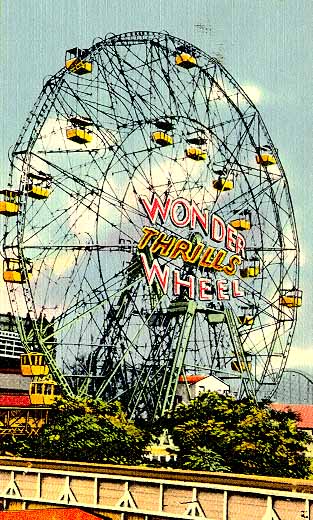 |
